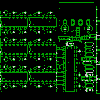20.9.2007 | 20:55
Ultra laser
An exotic molecule built from electrons and antimatter is being touted as a route to powerful gamma-ray lasers.
An electron can hook up with its antiparticle, the positron, to form a hydrogen-like atom called positronium (Ps). It survives for less than 150 nanoseconds before it is annihilated in a puff of gamma radiation. It was known that two positronium atoms should be able to bind together to form a molecule, called Ps2, and now David Cassidy and Allen Mills from the University of California, Riverside, have made that happen. First, they trapped positrons in a thin film of porous silica. Those positrons captured electrons to form positronium atoms, and the pattern of decay rates signalled that some of these atoms had teamed up to form Ps2 (Nature, DOI: 10.1038/nature06094).
If positronium atoms could be forced to merge into a kind of "super-atom" condensate, it would decay in bursts of identical gamma rays, which could lead to gamma-ray lasers a million times more powerful than standard lasers. "It's like comparing a chemical explosion with a nuclear explosion," Cassidy says.
http://technology.newscientist.com/article/mg19526216.000-antimatter-molecule-could-lead-to-ultrapowerful-laser.html
Flokkur: Tölvur og tękni | Facebook
Um bloggiš
Arnór Jónsson
Bloggvinir
Heimsóknir
Flettingar
- Ķ dag (1.4.): 1
- Sl. sólarhring: 1
- Sl. viku: 8
- Frį upphafi: 267
Annaš
- Innlit ķ dag: 1
- Innlit sl. viku: 7
- Gestir ķ dag: 1
- IP-tölur ķ dag: 1
Uppfęrt į 3 mķn. fresti.
Skżringar

Bęta viš athugasemd [Innskrįning]
Ekki er lengur hęgt aš skrifa athugasemdir viš fęrsluna, žar sem tķmamörk į athugasemdir eru lišin.